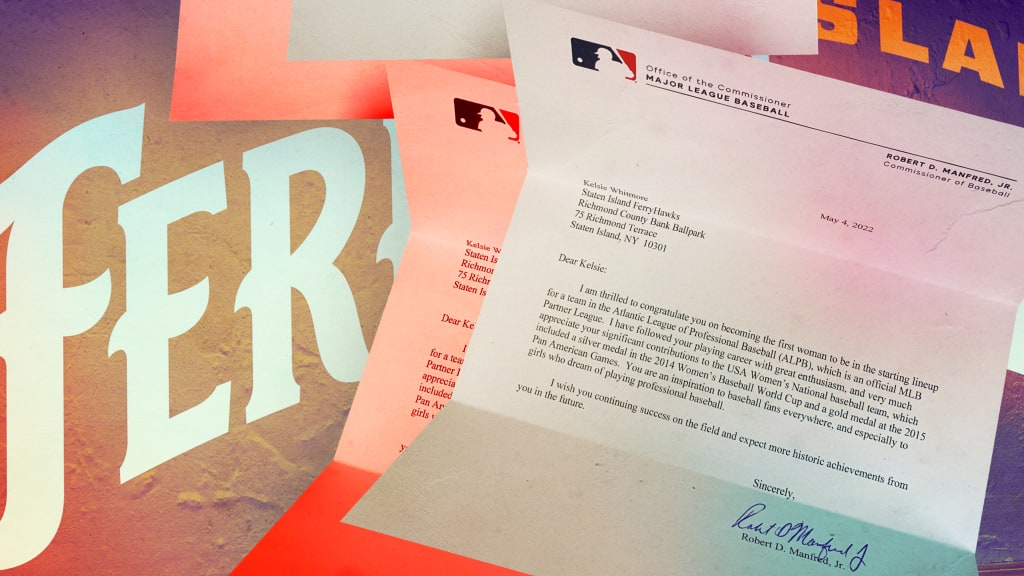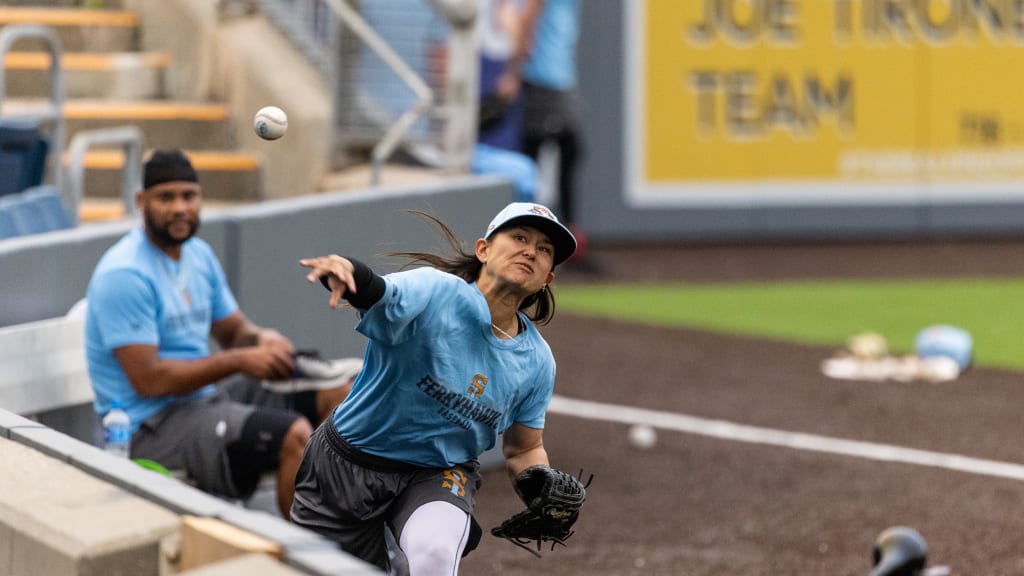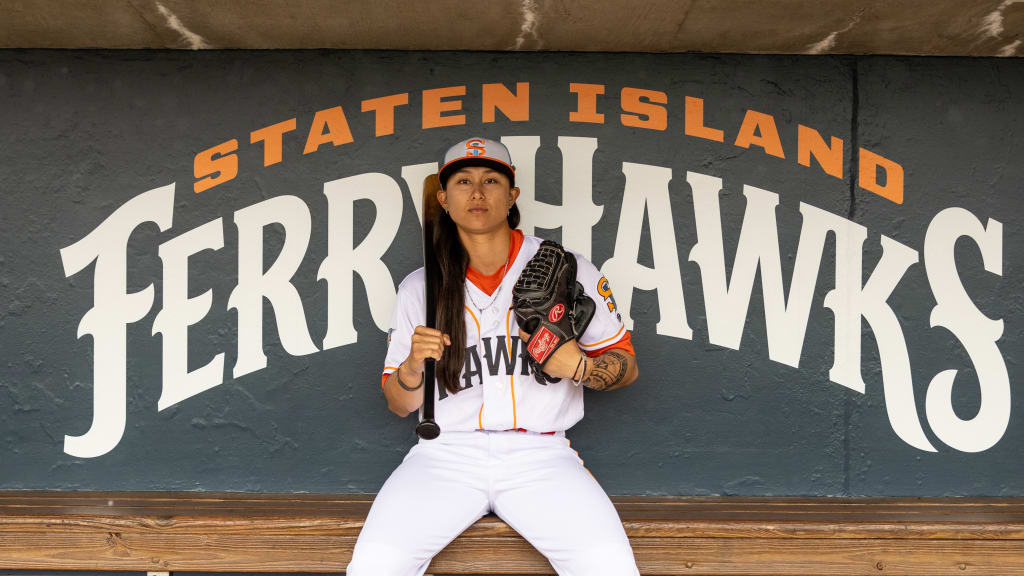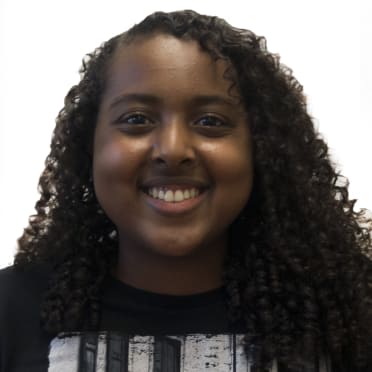NEW YORK -- Kelsie Whitmore already has a daily routine figured out: wake up, hit the gym and head to the ballpark. Then, throw with the pitchers, take swings in the cages or batting practice on the field and catch live reads in the outfield. Recovery comes next, and if there’s time, a second round of workouts in the team gym.
And once all of that is complete, there’s still a game to be played.
It’s an intense regimen, but that’s what it takes for a player trying to prove that they belong in organized baseball. Especially when your path toward that goal is as unprecedented as it comes.
On April 8, Whitmore signed a contract with the Staten Island FerryHawks of the Atlantic League, becoming the first woman to join a league affiliated with Major League Baseball; the independent Atlantic League was named MLB’s first Partner League in September 2020. While it wasn’t the 23-year-old’s first foray into professional baseball -- the San Diego native played for the Sonoma Stompers of the independent Pacific Association in 2016 and ’17 -- given the Atlantic League’s reputation as the highest level of the sport outside the Majors or Minors, it was certainly her most high-profile venture yet.
So much so that she received a personal letter of congratulations from MLB Commissioner Rob Manfred, who wrote, “I have followed your playing career with great enthusiasm, and very much appreciate your significant contributions to the USA Women’s National baseball team …” and called her “an inspiration to baseball fans everywhere, and especially to girls who dream of playing professional baseball.”
A two-way player who made a name for herself on the U.S. women’s national baseball team from 2014-19 -- winning a gold medal in the ’15 Pan American Games and a silver medal in the ’14 Women’s Baseball World Cup -- Whitmore has appeared in left field and as a reliever for Staten Island in a season that’s only about a month old. And she has made a lot of Atlantic League history along the way, debuting as a pinch-runner in the first game of the FerryHawks’ inaugural season on April 21, becoming the first woman to start a game on May 1 and becoming the first woman to take the mound on May 4.
But for Whitmore, the journey has only just begun.
*****

The FerryHawks’ home, Community Park, is located just off Upper New York Bay, steps away from both the recently opened St. George Ferry and the iconic Staten Island Ferry, which run across New York Harbor (hence the team’s name). Next to the ballpark is NYC’s first outlet mall, adjoined by a parking garage that rises several stories high and overlooks the diamond itself.
On a recent Friday afternoon, hours before a FerryHawks night game, Whitmore was walking up the long, steep hill from the docks to the streets when a chorus of high-pitched voices began yelling her name. A group of young girls was huddled at the edge of that parking garage, looking down and calling out to Whitmore, who happily returned their greeting.
There’s a lot of that attention going around these days for the newest face of the area’s new franchise. Gary Perone, the FerryHawks’ general manager, knew that would be the case when he signed her six weeks ago. He’s no stranger to the area, having spent nearly 15 years as assistant GM of the Brooklyn Cyclones, the Mets’ High-A affiliate.
But he did his homework on Whitmore, just like he would with any other player, talking with her on the phone, speaking to her parents and connecting with a host of people in her life over roughly three months. He wanted to know if this was something that she wanted to do. What he found out was the most enticing part.
“All signs were that she’s the hardest-working person that’s out there playing,” Perone said in a phone conversation. “As a person first and foremost, she really impressed me in terms of her dedication, her desire, her work ethic and where she sees herself going further in her career. So we felt this was a good opportunity for her to come here with us. And when you’re developing under two former Major Leaguers, it’s a really good plus for her.”
That first Major Leaguer is the FerryHawks’ manager, Edgardo Alfonzo (“Fonzie” for short), the Mets Hall of Famer who most notably led the team from Queens to the 2000 Subway Series against the Yankees. The second is pitching coach Nelson Figueroa (he goes by “Figgie”), another former Met who stood out because his fastball sat in the 80-mph range. It can't hurt, either, that Whitmore can count two-time Major League All-Star righty Julio Teheran and former big league outfielder Rymer Liriano as FerryHawks teammates.
When Perone reached out to Figueroa to see what he thought of Whitmore’s chances as a pitcher, the coach went off to research the 5-foot-7, 140-pound right-hander. After one hour-long phone conversation and never having seen her throw a pitch, he was convinced.
“If she was 6-foot-4 and threw 95 mph, she’d be in the big leagues,” Figueroa said. “She has that kind of makeup and that kind of tenacity in everything she does. She’s very detail-oriented. She knows what she can do. She knows what she can’t do.
“I told Gary, ‘Bring her in. We’ll take a look at her during [tryouts]. Then we’ll put her up against our hitters and see what she can do. And if she can’t do it, she’ll realize it before we do.’ And all she did was go out and impress.”
*****

Being a professional baseball player is what Whitmore always wanted. But when there’s no set path as a woman in the game, it can be even harder to see how that could actually be possible.
She took all the usual steps: starting at a young age (6 years old), competing for her high school as a varsity athlete (even though she was the only girl) and playing travel ball (including once for an all-girls squad called the “Dream Team” that finished second in a Las Vegas tournament that also featured boys’ clubs). She fell in love with baseball and “never fell out of love with it.”
Whitmore began playing for Team USA when she was just 14 and had to balance high school with traveling around the country and the world, winning gold in Toronto and silver in Japan. She was a two-way player then, too, but she starred on the mound, compiling a 1.35 ERA in her five years on the roster.
It was Whitmore’s first major experience playing the game with all girls, with whom she made lifelong friendships and lasting memories -- like the time the Yankees hosted the team ahead of the 2015 Pan Am Games, inviting them to watch BP, meet the players and even run out onto the field for the National Anthem in full uniform alongside the Yanks.
Jade Gortarez, an associate amateur scout with the Red Sox, was one of those friends. She and Whitmore grew up about 20 miles away from each other in Southern California and were both on that “Dream Team” as tweens, but they grew closest as the youngest players on Team USA’s roster.
As is often the case, when it came time to attend college, the girls faced a crossroads about the next phase of their journey: baseball or softball? They both went the softball route.
“[Neither] me nor Kelsie was going to go out and play Division I baseball,” Gortarez said via phone, “for simple reasons like we just don’t throw hard enough, we’re not faster like all those other guys. It was just about fitting into the right space where you can be successful. … I think, for both of us, it was just a better opportunity. And, you know, obviously college is expensive.”
Whitmore took a scholarship to play softball for California State Fullerton, and even though it was a “hard transition” for her both emotionally and physically, she found success with the Titans. She appeared primarily as a pinch-runner and stole 15 bases in those first couple of years, during which time she had also been trying her hand at indy ball with the nearby Stompers.
In the summer of 2016,when Whitmore and fellow Team USA standout Stacy Piagno joined Sonoma's roster, they became the first female teammates in professional baseball since the 1950s, when women played in the Negro Leagues. During one game that season, Whitmore pitched to another member of that gold-medal winning squad, Anna Kimbrell, forming the first all-female battery since the World War II-era All-American Girls Professional Baseball League, upon which the famous film “A League of Their Own” was loosely based.
“She was there to grow as a person and as a player and just continue to develop,” Gortarez said. “She knew that she wasn’t going to go out there and start or play every single game, but her motor and just the way that she thinks -- she’s probably one of the biggest students of the game that I’ve ever met in my life. Like she just always wants to get better, get better, get better, no matter what it looks like on the outside.”
Whitmore broke out as an upperclassman on the Titans’ softball team and was named the Big West Conference Player of the Year in 2021, her fifth year of NCAA eligibility due to the COVID-canceled ’20 season. She had one of the best offensive campaigns in school history, including reaching base safely in 29 straight games and putting together an 18-game hitting streak (the program’s second-longest mark all-time).
But when Perone reached out with an offer to return to the sport she had always longed for a future in, Whitmore’s decision was simple.
“I’m here because: one, I love this game and two, I want to continue playing it,” she said. “And just like if you went out there and you asked any other guy what he’s doing here, my answer is the same.
“We all love the same thing, and we’re all trying to get after the same dream.”
*****

In the Atlantic League, what some call a “second-chance league,” the goal ultimately is to make enough of an impression that a Major League organization will come calling with an opportunity to join one of their Minor League affiliates. For that reason, it’s primarily a developmental space, where players work on their skills and improve their tools in order to draw interest from scouts.
With the FerryHawks being a new team, Figueroa put out a text to his pitchers at season’s start, asking them about themselves, what they’ve been practicing and the role they’re looking to play with the club.
Whitmore’s response was a four-page-long message, to which Figueroa thought, “Would I expect anything less from her?”
“She knows how to pitch,” he said. “She has pitched at a high level for a long time. Once you go and you play at 60 feet, six inches and the bases are 90 feet, it doesn’t ever go backwards; it doesn’t ever change. … It’s just being as consistent as possible and not making mistakes. You don’t usually get a second chance to make a mistake at this level. And she’s learning that.
“She had success in her first outing, and she tasted a little bit of failure in her next outing. The problem was it was on back-to-back outings. There’s a lot of guys that, because it’s early in the season, will refuse to go back-to-back; they don’t want to push it. We had a situation where we needed her to maybe throw an inning, and she didn’t bat an eyelash and ran out to the mound.”
In that first outing on May 4, Whitmore was summoned to help the FerryHawks escape a bases-loaded jam with two outs in the top of the ninth. Despite the heightened pressure of the situation, Whitmore maintained her composure, ending the threat in four pitches: ball, strike, strike, flyout.
Though she didn’t fare as well in that second outing, it was a learning experience for her, the way it’s supposed to be at this level. The same is true for her results at the plate so far, where she has gone hitless in five appearances but has reached base via a walk and a hit-by-pitch. She’s a role player, and her “tremendous flexibility” is an asset to the team.
“She does a lot of things, and she does a lot of things well,” Figueroa said. “She’s going from guys barely touching 85, 90 to consistently 95, and she’s put up a fight in every single at-bat and has not been overwhelmed. … And there is something to be said about people who throw below the radar.
“They’re not used to seeing that. And she actually surprises a lot of guys with her fastball because they sit there waiting for something slower at all times, and she’s able to sneak up on them. So she’s still a work in progress when it comes to that, but when it clicks, it’s going to be really, really exciting for her.”
Gortarez has been watching Whitmore in action for more than a decade now, and whenever they were both in town after their collegiate softball seasons, Gortarez would reach out to Whitmore with a request to hang. The response she received would often be a variation of the same refrain.
“She’s like, ‘Yeah, I’m available today, but let me get this workout in first.’ Or she’s like, ‘Maybe not today, I’m already at the field,’” Gortarez said. “Like that’s just the type of person she is. She’s at the field every single day. She doesn’t believe in off-days. She’s just crazy in her work ethic. … Speaking in my terms, we would call her an 80-makeup kid.”
That 80 refers to the highest score a scout can give a prospect on the 20-80 scale when rating their tools and intangibles in anticipation of the next level -- the place that every player strives to go.
Whitmore included. Even though it’s never been done before. Even though this is just another stop on the journey. She knows what’s possible now. She’s starting to see it.
“Of course. That’s the big dream,” Whitmore said. “I wouldn’t be playing this game if I didn’t have the mindset and the drive to want to hopefully, potentially, get there one day. It’s definitely going to be hard; it’s not going to be easy. But it’s definitely something that I -- in my head -- dream about, visualize, want to even just imagine it.”
*****

As much as Whitmore is chasing this career for herself, she also knows how much it means to have a woman playing baseball at this high a level. She knows it by the young girls she meets at the ballpark, by the people who ask for her autograph wherever she plays and by the collection of fan mail she routinely finds behind her locker room door.
It’s all part of her path, and she embraces it as such. For everything the game has given her, she gives back just as much, working as an instructor for youth baseball development programs like the MLB Grit: Girls ID Tour and the Girls Baseball Breakthrough Series in the last year.
“Her ability to play and be on the field has created a lot of excitement for young girls,” Perone said. “That’s something that we’ve definitely seen firsthand [with] a lot of teams, not just on Staten Island but around the league in general. Everybody’s excited to see her and to meet with her.
“Kelsie’s message of making an impact, of showing people they could do anything possible, is one that’s going to be great. … Her personality and what she’s doing is really, really something special.”
Whitmore, for her part, makes sure to keep her focus firmly planted on the field. That’s what has guided her to where she is now, and it’s what makes everything else happen, too. She’s a baseball player, and she’ll continue to prove it for as long as she has to.
In her Atlantic League debut in Charleston, S.C., when Whitmore entered as a pinch-runner and toed the first-base bag, she started to hear some chatter from the opposing fanbase -- “You can’t run. You’re not fast.”
Clearly, they weren’t familiar with her story. Whitmore knows how to take an opportunity and run with it.
“She literally told me, ‘All I kept saying in my head was, please God, let there be a ball in the gap so I can score from first. And if I need to run over the catcher, I will,’” Figueroa recalled.
“And that summed it up right there. There’s no shyness in her game. She knows who she is. Her intensity is second to none.
“And I stand by what I’ve said -- if she was 6-foot-4 and threw 95 mph, you wouldn’t be just hearing about her. You’d be watching her on TV.”
If Whitmore has it her way, one day they will be.
